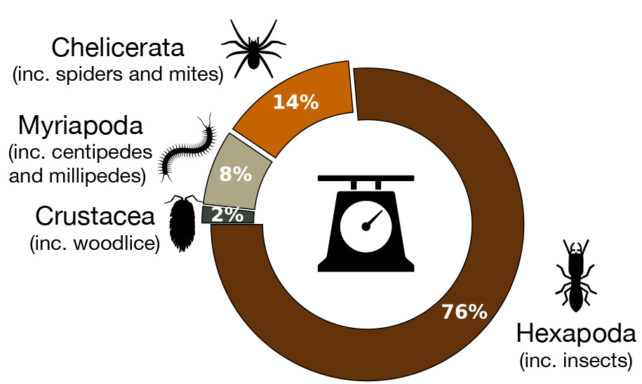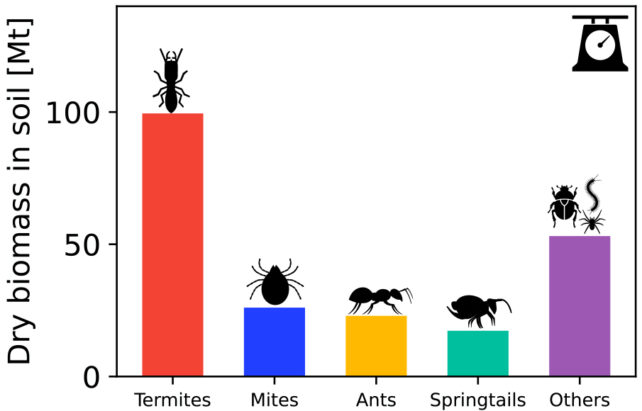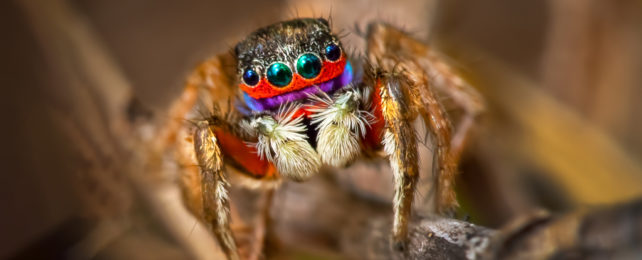Without the buzzing, fluttering, scuttling or creeping crawlies our world would be in strife. Yet we don't even know some of the most basic things about these arthropods like butterflies, spiders and centipedes, such as how many of these important components of our world's biosphere are even out there.
So researchers crunched some numbers to arrive at a startling conclusion: despite their minuscule size, the collective global mass of all terrestrial arthropods is about the same as all humans and their farm animals combined.
No wonder they have such a massive impact on the world we live in.
"Arthropods have been described as 'the little things that run the world' because of their central role in multiple ecological processes," explains Weizmann Institute of Science environmental scientist Yuval Rosenberg.
"We must take them into account if we're to fully understand humanity's impact on the planet and the possible consequences of climate change."
So Rosenberg and colleagues amassed 7,000 measurements from the scientific literature. From deserts to farms to rainforests, these records include all the major terrestrial habitat types, scattered across 300 locations around the world.
They categorized the records into soil (including plant litter) and above-ground (surface and plant-associated bugs) arthropods, because of the very different sampling techniques involved for each group.
The data suggests most of that 1 billion tons worth of arthropods are found snugly tucked on or within our planet's skin.

Termites make up about a whopping 40 percent of the arthropod soil biomass, far more than ants at around 10 percent.
"Every square meter of top-soil contains tens of thousands of arthropods on average, the vast majority of which are tiny mites and springtails," the team writes in their paper.
Just the arthropods that live on and in the soil alone add up to around 10 quintillion individuals (that's a 1 followed by 19 zeros). These tiny critters help cycle nutrients within the soils, contributing to the global carbon cycle in the process.
The figures the researchers arrived at for above-ground arthropods are a lot less certain. The team found limited data on flying insects. But combined with the soil group the mass of these animals is greater than the collective mass of all remaining wild mammals. But there's still an even greater biomass of tinier soil microbes and marine arthropods.
"The figure corrects the impression that we're dealing with infinite, inexhaustible arthropod populations," says Milo. "Despite their broad distribution, that is not the case."

Understanding the distribution of this biomass can help us work out exactly how they fit into wider ecological systems and predict the impact of their declines. For example, understanding the distribution of termites allows estimates of their contribution to global warming.
"[Arthropods] are a massive force when it comes to regulating vegetation," notes Rosenberg. "Thousands of species of birds, reptiles, and amphibians depend on them for food and, ultimately, arthropods help break up and recycle dead plants and animals, as well as their excrement. This has huge implications for us as well. Even a service that may seem minor, like breaking up excrement, not only fertilizes the soil but prevents disease and pest outbreaks."
Worryingly, just like much of the rest of life on Earth, terrestrial arthropods, particularly the data deficient flying insects, are also in decline. We rely on these insects to help put food on our tables through pollination and nutrient recycling.
"Quantifying arthropod populations establishes a baseline against which we can measure future changes to the arthropod communities and how these changes, in turn, could affect global processes," concludes Rosenberg.
This research was published in Science Advances.
